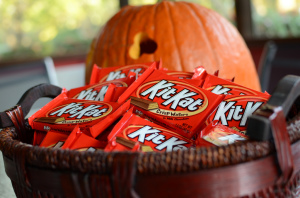I love this information from Think Progress:
“This year, Halloween candy sales could top $2.5 billion this year across the United States, with chocolate being the heavy favorite for most consumers. The problem, apart from tooth decay and the consequences of high-sugar diets, is that many of the candies Americans will be consuming in large quantities contain a little-known ingredient that may not be flashy, but can have serious consequences for the climate.
Palm oil, the world’s most-used cooking oil, is cheap and versatile, trans-fat-free, and found in everything from food to makeup, biofuels to candles, cleaning agents to candies. In 2013, the world produced 50 million metric tons of the stuff — in comparison, it produced less than three million tons of olive oil.
Ordinarily a useful industrial and food product that could grow back and renew itself would be a climate boon, but palm oil has a problem. It can only grow in tropical climates, and palm plantations require a great deal of clear-cut land to produce the oil — most current cultivation is in Indonesia and Malaysia. This means deforestation and the massive amounts of carbon released into the atmosphere that comes with it, but also the loss of peatlands, a far less sexy but just as significant climate problem. As Harrison Ford discovered in this year’s big climate documentary series, “Years of Living Dangerously,” peat contains much more carbon than tropical forests do, so when plantations drain peatlands, that carbon gets released into the atmosphere.
Rainforest Foundation U.K. has a palm oil producgt guide, which rates chocolate manufacturers on a one to twenty “ethical score.” Ethical Consumer, which did the research for the guide, says that top scores either mean the company uses no palm oil or 100 percent Fairtrade palm oil. Italian confectioner Ferrero bottomed out with a score of one while Mars only reached a seven. Nestle was rated a bit better with a twelve, Lindt hit 14, and Booja Booja and Divine Chocolate aced the guide with perfect “20″ ethical scores.
The El Paso Zoo lists a few dozen candy brands that contain palm oil and several dozen more than contain none. If you aren’t sure, go by the ingredient list, but it’s not enough to look for “palm oil” there. Often companies use different names or derivatives, but the Cheyenne Mountain zoo’s palm oil webpage contains a comprehensive list of possible palm oil ingredient names. Some of the most common ones are “vegetable oil,” “stearate,” or “stearyl.”
The sure-fire winners either skip palm oil altogether or deliberately source it from sustainable producers. Diana Donlon, the Director of the Center for Food Safety’s Cool Foods Campaign, writes in Huffington Post that parents and other candy consumers can vote with their wallets this year. She details four chocolatiers who use ethical palm oil or no palm oil at all:
- Endangered Species Chocolate: uses a high certification for its chocolate and donates 10 percent of net profits to conservation groups
- Justin’s: uses palm oil from highly-ranked climate- and conservation-friendly palm oil producer Agropalma
- Equal Exchange: doesn’t use palm oil at all, and works with small farmer co-ops
- Alter Eco: uses organic, fair trade coconut oil”


